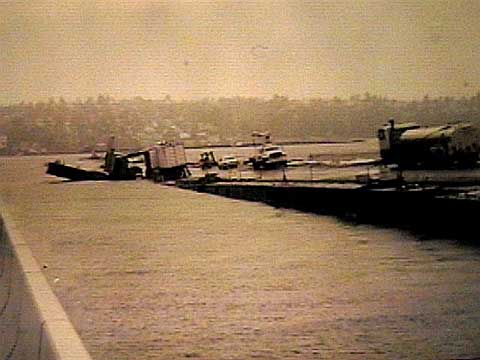

On November 25, 1990 the Lake Washington Floating Bridge broke into sections and a large portion of it sank and the remaining portion was damaged beyond repair after taking on water during an extensive storm known as the “Thanksgiving Floods”.

“My state is falling apart on me”—Washington Governor Booth Gardner[1]
It was later discovered that mistakes made during the in progress rennovation combined with abnormally large amounts of rain, waves, and a high lake level lead to the catastrophic failure.
“Sections of the 6,500–foot span sank after lake water leaked in through cracks in the bottom of one of the middle pontoons. The cracks developed after large amounts of waste water used in the renovation project were stored inside bridge, according to the state.”[2]
Eyewitness accounts of the bridge’s failure from The Seattle Times:
“Kinoshita, a state assistant project engineer working on reconstruction of the bridge, arrived at the span at 8:30 a.m.
The waters of Lake Washington, swollen from days of rain, were within a foot of the bridge deck.
The bridge pontoons were filling rapidly, Kinoshita said, and pumps, which had been in place for several days, were not keeping up.
Workers on the bridge from Traylor Bros. were on scene and were fighting to keep the bridge afloat. The bridge was shaking and making groaning sounds.
“We were losing it,” Kinoshita said.
Kinoshita said he was not frightened.
“I’m a good swimmer,” he said, smiling.
But even so he knew the bridge was in desperate danger.
Water was coming over the bridge by 9:25, so Kinoshita drove off, making it to a transportation department office at the west end of the bridge.
He phoned for more pumps – just as the bridge broke up.
A resident near the west end of the bridge, Ken Henderson, heard a “terrible racket” and looked up.
“The pavement was wavering and then it fell. Out in the middle of the lake I saw a white cloud, a portion of the bridge was sinking,” he said. “I called 911 and said there was some sort of catastrophe.”.
The center span “looked like it was closing in on itself,” said Jerry Walker from his island viewpoint. “One section (of the span) was listing, and about five minutes after we got there it sank.”.
A red construction crane toppled into the lake.
The east and west ends of the central span were pushed north until the span formed a “V,” witnesses said.”[3]
After the disaster traffic was redirected onto the neighboring floating bridge constructed in 1989, which would later be renamed the “Homer M. Hadley Floating Bridge” after the man who started it all. The Lacey V. Murrow bridge was rebuilt from funds gained in a settlement with Taylor Bros. the contractors who were rennovating the bridge when it sank. The replacement Lacey V. Murrow Floating Bridge opened in 1993 and currently carries the Eastbound traffic of Interstate 90 across Lake Washington.[2] [4]
“Construction practices and procedures should be conducted with a mind–set of “whatever it takes to keep the bridge afloat” and take extra precautions to assure this is the case. The watertight status of the bridge must be maintained.”—One of the recommendations of the blue ribbon panel which investigated the sinking[5]